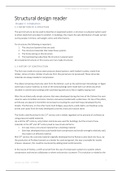Samenvatting
Summary Structural design (statics of structures course)
Summary of the structural design reader and the lecture series for the first year course Statics of structures for architecture, urbanism and building sciences students. The content of the lectures is included.
[Meer zien]




